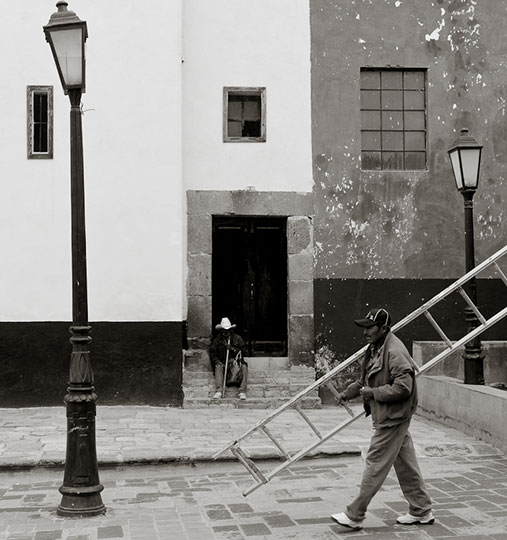
Lamp & Ladder – San Miguel de Allende, Mexico. February, 2010
Leica M9 with Tri-Elmar @ 35mm. ISO 160
When I do portfolio reviews with students and I discuss an image of theirs that I don’t feel has been successful, the question that I ask is –What is it about?This seemingly innocent question is, in my experience, one which causes any photographer to reflect on their own work in a way that is necessarily part of the creative process.
The photograph above,Lamp & Ladder, is one which I took in San Miguel de Allende, Mexico, in February, 2010. I’ll use it as an example of the thought process used in both taking the photograph and also in preparing it for printing. This process will be taken step by step, deconstructing the image and finally, declaring what it is "about".
____________________________________________________________________________________
The Predecessor
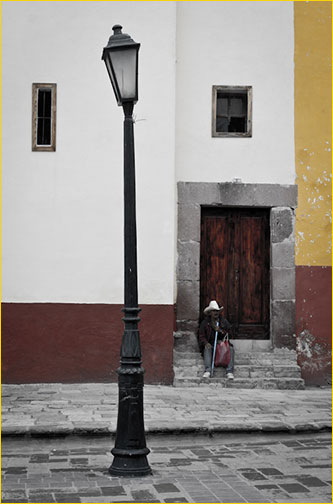
First attempt
A morning walk through one of the squares in San Miguel; just a stroll with a friend and fellow photographer. We noted the man sitting in the rectory doorway of the church, and also the tilted lamp. Together with the wall colours and shapes not an unattractive composition, and so I took a few shots. In post I desaturated the file to give it a somewhat more timeless look, and while it’s a pleasant enough shot, I find it bit too studied.
____________________________________________________________________________________
The Shot
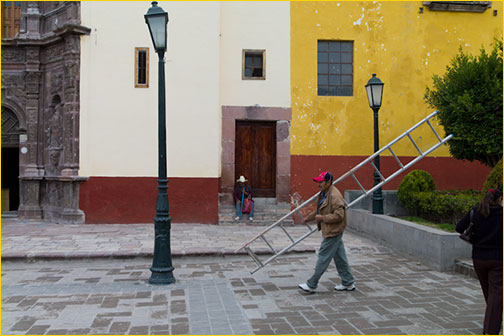
…as shot
So, we waited for something to happen. I wasn’t sure what exactly, but figured that eventually something might. As Alejandro and I stopped chatting and simply watched the passing scene, I noticed out of the corner of my eye a man walking by with a ladder, and took a quick shot.
I had prefocused the M9 on the foreground lamp post and pre-set an aperture of F/11 so as to have enough depth of field back to the church, and also foreward to anything that might appear in the foreground, using a 35mm focal length. When I took the frame I was prepared for the unexpected, if you know what I mean, but because the photograph was taken on the fly (up to my eye, frame and shoot in just an instant) my composition wasn’t as careful as it might have been, and I almost chopped off the top of the lamp post. If I had, the shot would have failed. As it is the crop is too tight for comfort and also text-book rules of composition, but no matter. It’s in.
____________________________________________________________________________________
The Crop
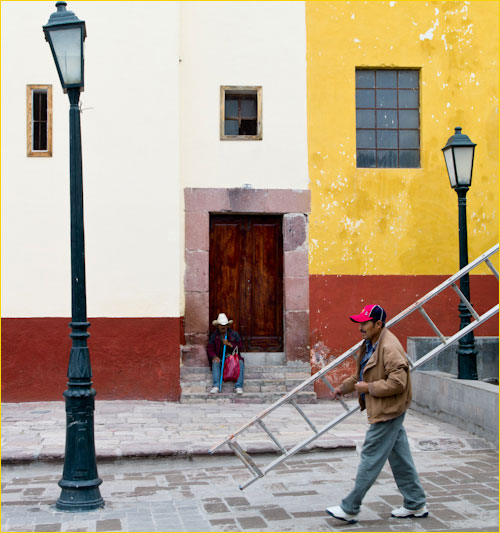
..cropped, with basic exposure correction
The reasoning behind this cropping is simple – I asked myself what the shot was about? The answer was that the shot is at its core about the building and the two men, especially the one with the ladder. The church doorway on the left and the foliage on the right, along with the random pedestrian, were extraneous, and therefore needed to be removed. As this was a grab shot, not a composed one, I ended up with an aspect ratio determined by the content of the image, not by the camera maker – which is the way that I always work. The subject dictates the format of the image.
Some basic exposure compensation was done to put a little life into the image, because the day was overcast and quite dull. This brought it to the stage that you see immediately above.
But, i wasn’t satisfied. I felt that being in colour made the shot too literal, and also somehow detracted from the graphic aspect of the image – the shapes and subject relationships. The photograph wasn’t about the colours of the wall, the hat and the bag, and so I decided that they had to go.
____________________________________________________________________________________
Monochrome Conversion
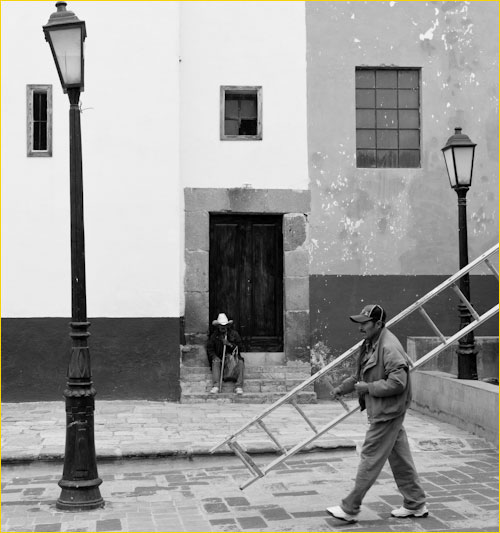
For anyone that used to shoot B&W in the film days, the ability now with digital to shoot in colour and then convert to monochrome is a pleasure. Not just for the ease of doing so, but because one can change the luminance values of colours in the image in the same way as we would by using coloured filters and panchromatic film, but with the creative freedom to do so after the fact.
Above is a straight conversion using the B&W conversion tab in Lightroom, with the Auto setting. It’s fine, and the tonal values are nicely distributed, but I wanted to have a bit more contrast between the yellow and the umber wall sections. This was easily adjusted to taste with the B&W Mix sliders, with the final settings seen below.

____________________________________________________________________________________
The Final Print
With cropping, exposure adjustments, monochrome conversion and luminance tonal values adjusted to taste, the one thing that I felt that the photograph needed was a slight warm tone. The conversion to B&W was what I wanted, but something of the warmth of the scene had been lost. I ended up using a setting of Hue=50, Saturation=11 on the Shadow slider of the Split Toning tab in Lightroom to give the print just a slight bit of warmth and therefore, hopefully, greater visual interest.
Appropriate sharpening was the final step, and the result is what you see blow.

Lamp & Ladder – San Miguel de Allende, Mexico. February, 2010
Leica M9 with Tri-Elmar @ 35mm. ISO 160
____________________________________________________________________________________
What’s it About?
So, now we come back to the initial question. What is the shot about? Some might say that it’s about the two men, one elderly, seated, and passive, while the other is younger, in motion, and obviously going about his business doing a job.
Or, we might say that the shot is about the relationship between the tilted top of the lamp post along with its rigidity, and the contrasting angle of the ladder and its being in motion. Who knows? Maybe the ladder is on its way to being used to fix the lamp’s tilt; a story being told in the process.
Or, is the shot about the geometry of the scene, with paving squares, window and doorway rectangles and painted sections forming a Mondrian-like stage upon which the men are cast, while the lamp posts and ladder provide contrast and visual tension?
Which is it? For me it’s all of the above, and it would be how I would answer the question –what is the photograph about?
When you look at your own photographs, ask yourself that simple qustion and see what answers you come up with. In the end, if you can’t answer the question convincingly, maybe the shot is not as successful as you might have thought it to be.
February, 2010
You May Also Enjoy...
About the Luminous landscape
The AuthorThe author of this site isMichael Reichmann— a widely published photographer, author, and a photographic educator for much of the past 35 years. This
